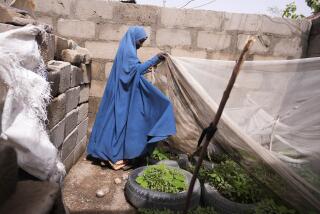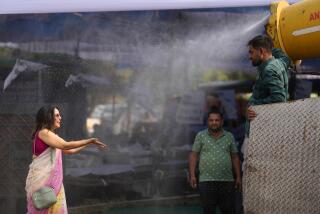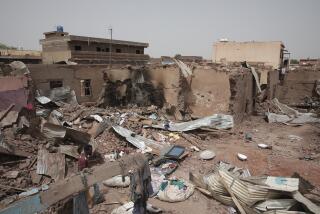Fewer people dying in Darfur, aid groups say
- Share via
HABILLAH, SUDAN — Something remarkable happened this year at a clinic for malnourished infants in this West Darfur village: It ran out of patients.
And physicians at the Doctors Without Borders clinic haven’t seen a single gunshot wound since last year. Now they’re thinking about closing down because there is a hospital next door run by another aid agency, and a third center is under construction.
“It’s getting a bit crowded here,” said Sewnet Mekonnen, the clinic’s field coordinator. “We’re not seeing as many emergencies.”
The clinic’s situation highlights one positive trend lost in the barrage of grim news that continues to pour out of western Sudan: Fewer people are dying.
At the peak of the Darfur crisis three years ago, health experts estimated that 6,000 to 10,000 people were losing their lives each month to disease, hunger and violence. Today, thanks to a drop in violence and improved healthcare, that figure is estimated at 100 to 600 a month, based on United Nations mortality estimates, news reports and interviews with U.N. officials, aid workers and Western diplomats.
Exact figures are unknown because, even though the U.N. and the African Union have large missions in Darfur, no agency is officially keeping track of civilian deaths.
The U.N. informally collects reports of violence-related civilian deaths, but doesn’t make the data public because it cannot verify their accuracy. However, U.N. officials did confirm a downward trend.
“Violence has subsided in the first part of 2007 and this definitely has affected the death toll,” said Ali Hamati, the U.N. spokesman in El Fasher.
Those who have reviewed the U.N.’s weekly compilations say violence-related casualties this year have averaged 100 to 200 a month, with the largest number of recent deaths arising from inter-tribal clashes in southern Darfur. Overall, civilian casualties in Darfur were down 70% in the first half of 2007, compared with the same period last year, U.N. figures indicate.
Officials emphasized, however, that even with the drop in fatalities, violence and insecurity in Darfur remain a problem.
“Harassment is still going on, rape is still going on, attacks are still going on,” said Annette Rehrl, spokeswoman for the Office of the U.N. High Commissioner for Refugees. “But the killing is not on the large scale that we saw before.”
Since the Darfur rebellion erupted in 2003, about 200,000 people are believed to have died, mostly of disease and hunger, though the Sudanese government says the death toll is 5,000. Some Darfur activists estimate that as many as 450,000 people have died.
Sudan’s military regime, dominated by Sudanese Arabs, is accused of responding to the rebellion by arming nomadic militias, called janjaweed, to attack and pillage villages supporting rebels, many of whom increasingly call themselves “Africans.” To date, about 2.5 million people have been displaced.
Some attribute the recent reduction in deadly violence to the growing international pressure on the Sudanese government and to the splintering of the rebel movement into rival factions, resulting in fewer clashes with government troops. Others see a change in tactics by janjaweed, shifting from large-scale massacres to other forms of intimidation.
“It’s like they are getting smarter,” said Gry Tangstad, a U.N. human rights worker in El Fasher, state capital of North Darfur. “They’re still attacking, but often they are just scaring people or preventing them from their livelihoods. We’re not seeing entire burned-out villages like we did in 2004.”
In one North Darfur village, for example, janjaweed cut off access to the water source in July, forcing residents to move to a displacement camp without firing a shot. In another incident last month, militiamen burned down two huts and killed two people in the village of Hajar, but were able to loot the entire village because hundreds of residents immediately fled, according to a U.N. report.
Such quick escapes are another reason for a decrease in the number of deaths, experts said.
“People are moving at the first sign of trouble, and as a result, not losing their lives in the same number,” said Fleur Auzimour Just, a program advisor at Care International in Khartoum, the Sudanese capital.
Rape is increasingly used as “a weapon of war to cause humiliation and instill fear,” said the Office for the U.N. High Commissioner for Human Rights.
A recent report by the agency mentions 50 women in Deribat, South Darfur, who were raped and some held as sex slaves for a month by armed bands, allegedly supported by government troops, who attacked their town in December 2006.
However, the overall decline in violence has led some aid officials and diplomats to raise questions about whether the conflict should still be characterized as genocide, a position held by the U.S. government and several international activist groups.
“The idea that thousands are still being killed by janjaweed is a myth,” said a Western diplomat who spoke on condition of anonymity because he was not authorized to make public comments. “The genocide happened. And it ended. To say otherwise is obscuring the reality of Darfur.”
Darfur activist Eric Reeves, an English professor at Smith College in Massachusetts, agreed that fatalities probably are at the lowest level since the conflict started, but said that conditions remained tense and fatalities could increase quickly if fighting resumes or humanitarian groups withdraw.
Reeves said civilian deaths had declined, in part, because many people in Darfur are living in displacement camps. “There just aren’t that many villages left to attack,” he said, calling the current environment “genocide by attrition.”
Another major factor has been the aggressive international humanitarian campaign led by the U.N., involving more than 12,000 workers at a cost of nearly $700 million annually.
Since 2005, key indicators, including mortality and malnutrition rates, have been improving steadily. Today those rates are not only below thresholds commonly used internationally to define an “emergency,” but in some cases, they are better than before the conflict, or better than those observed in other parts of Sudan and Africa.
“There is very little malnutrition and very little disease,” said Mike McDonagh, the north Sudan manager for the U.N. Office for the Coordination of Humanitarian Affairs. “We very quickly got it turned around.”
Malnutrition rates in Darfur have been reduced by almost half since 2004 to 12.9%, according to U.N. figures. The “emergency” threshold is 15%.
The mortality rate for Darfur is about 0.35 deaths daily per 10,000 people, according to the latest available U.N. estimates -- about one-eighth of the 2.9 rate seen in some areas in 2003 and 2004, and well below the 1.0 “emergency” threshold.
In fact, the mortality rate in Darfur is near, or perhaps even below, the region’s pre-conflict level. In sub-Saharan Africa, 0.44 deaths daily per 10,000 people is a common baseline.
“People in Darfur are now getting better healthcare than people in other parts of Sudan, such as the east and central regions,” said El Tayeb Ahmed, a Sudanese physician with Doctors Without Borders in Habillah.
Aid workers, however, warned that such progress does not mean the Darfur crisis is “fixed.”
An estimated 4.2 million people remain dependent on humanitarian aid. An additional 200,000 Darfur residents have been displaced since January. And health indicators are vulnerable to sudden changes. Aid groups recently began reporting an increase in moderate malnutrition in parts of West Darfur.
Meanwhile, violence has spread to neighboring Chad and the Central African Republic, where the aid presence is smaller and populations are more vulnerable than in western Sudan.
“It’s still a huge humanitarian crisis,” said Iain Hill, head of the U.N. refugee agency’s office in Geneina, West Darfur.
--
(BEGIN TEXT OF INFOBOX)
Glimmer of hope
Malnutrition rate for children younger than 5 in Darfur. The “emergency” threshold is 15%:
2004: 21.8%
2005: 11.9%
2006: 12.9%
Source: World Food Program’s “Emergency Food Security and Nutrition Assessment in Darfur, Sudan”
More to Read
Sign up for Essential California
The most important California stories and recommendations in your inbox every morning.
You may occasionally receive promotional content from the Los Angeles Times.










